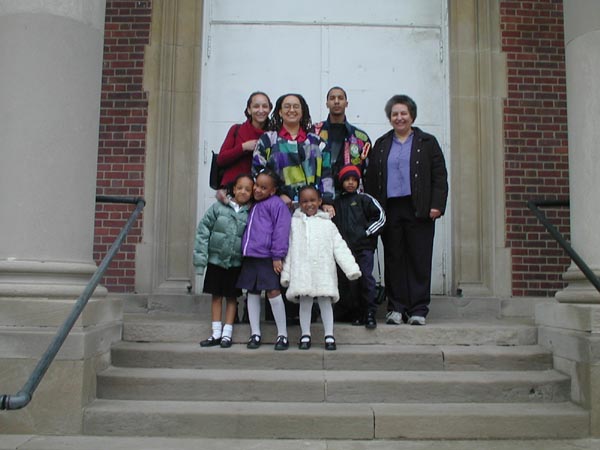Today I came across this Thanksgiving sermon from 1966 and decided to post it today, although this year’s Thanksgiving was several weeks ago. So many parallels between today and yesterday.
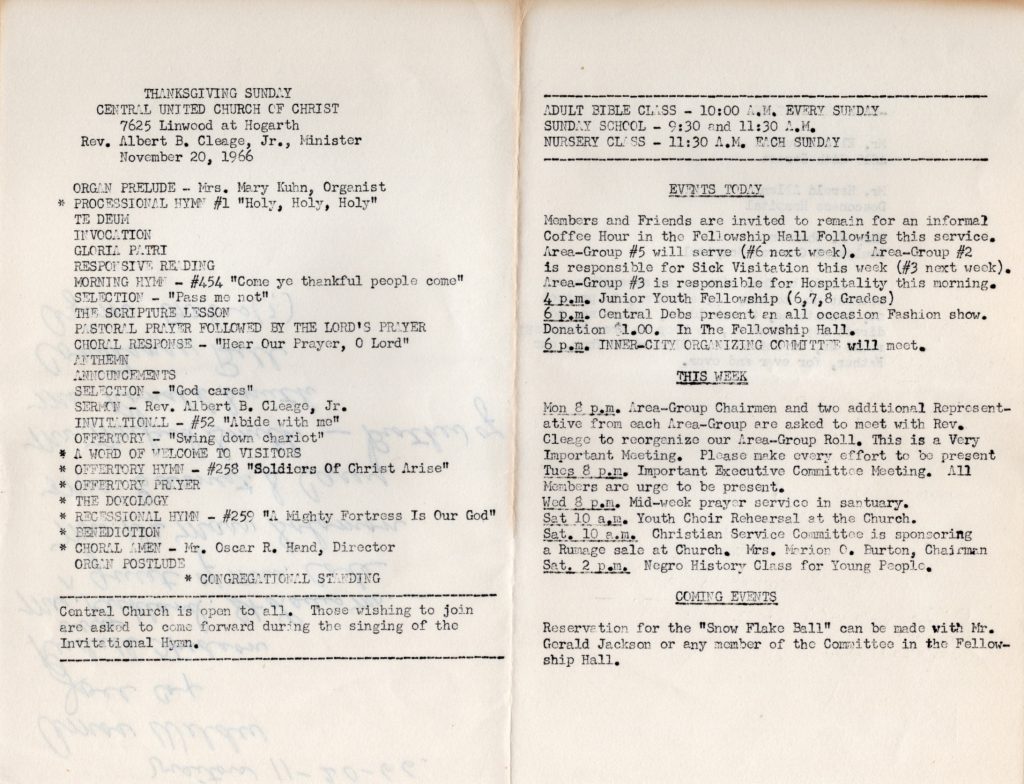
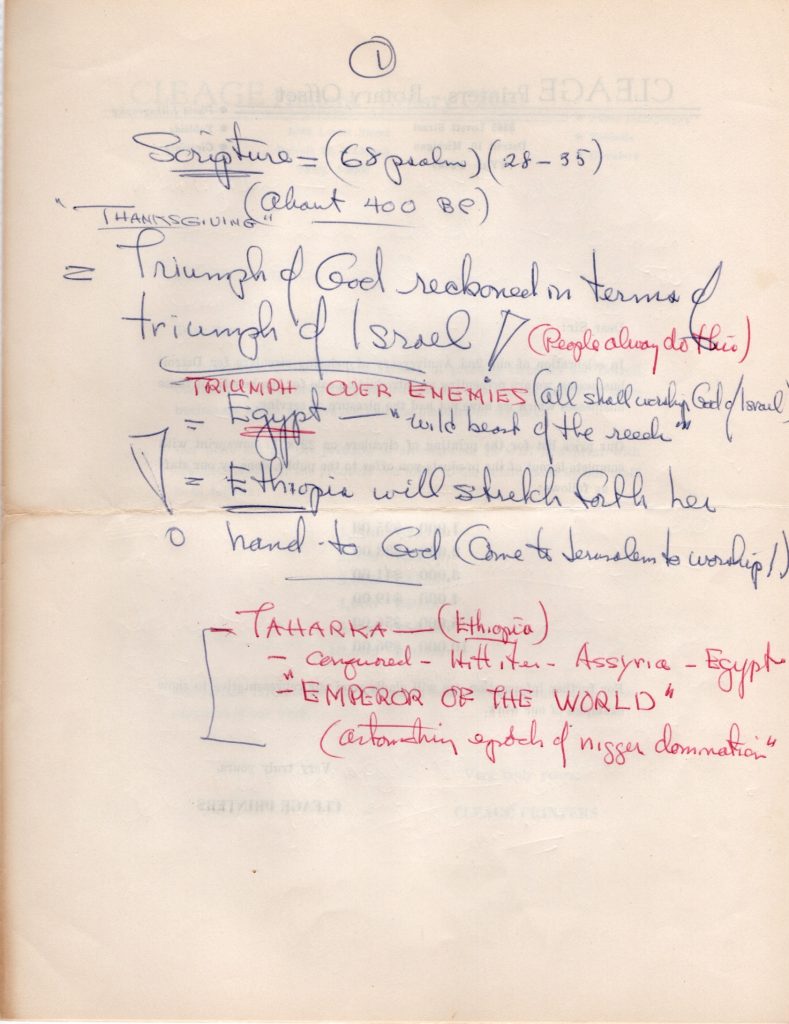
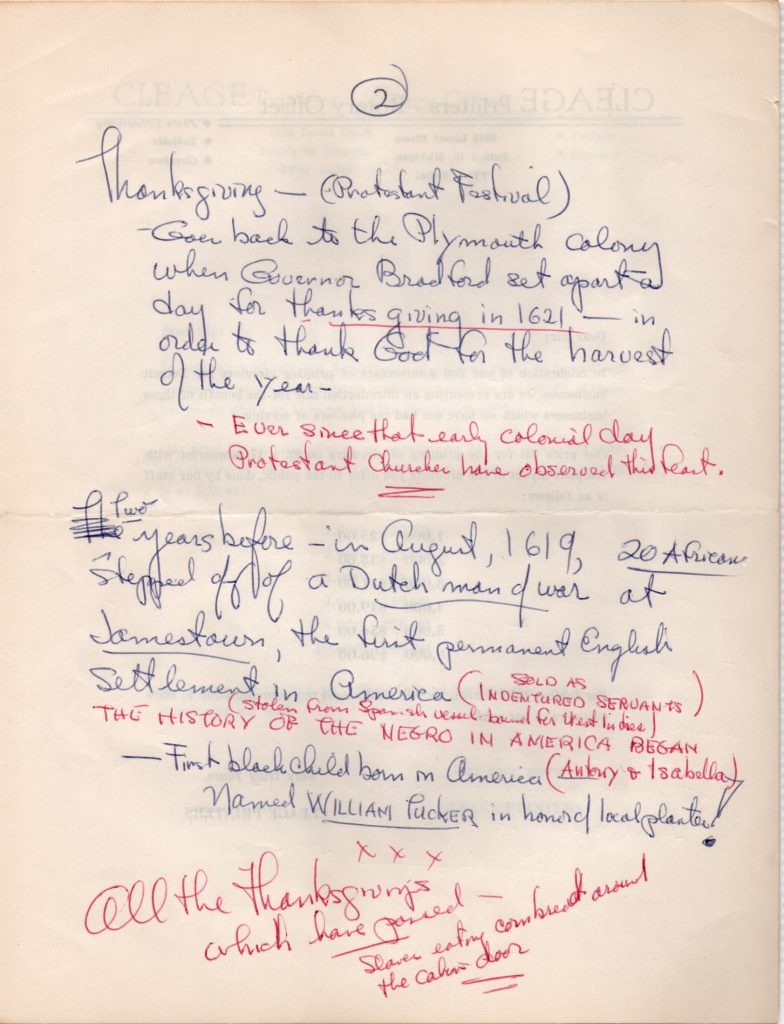
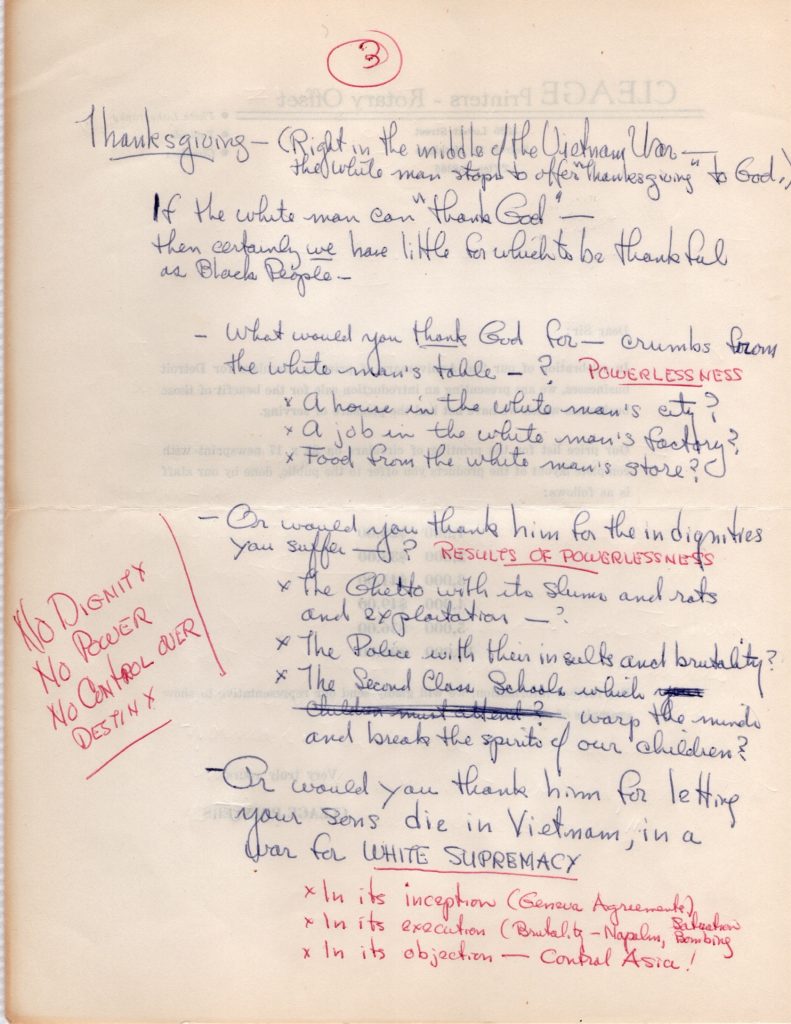

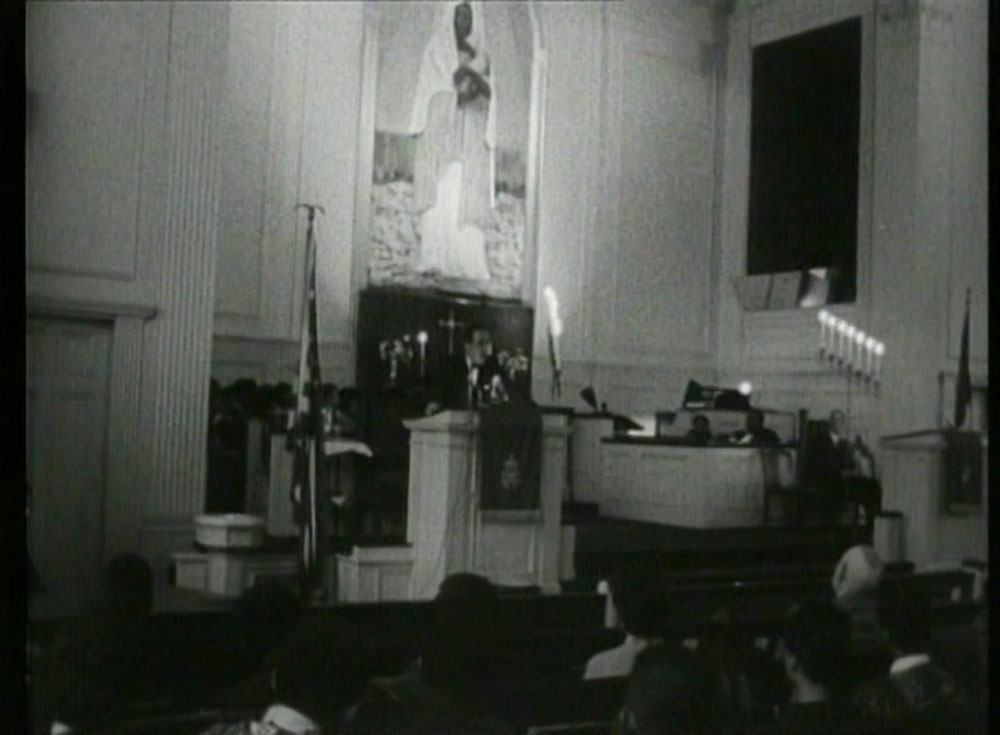 These are my father, Rev Albert B. Cleage Jr/Jaramogi Abebe Agyeman’s sermon notes for New Year’s Day of 1967. I also included the bulletin for that day and one of the songs sung by the choir. The painting of the Black Madonna and child in the photograph above was not yet painted on New Year’s day. It was painted during the spring of 1967 and unveiled on Easter Sunday of that year. The Detroit riot/rebellion occurred during the summer of 1967.
These are my father, Rev Albert B. Cleage Jr/Jaramogi Abebe Agyeman’s sermon notes for New Year’s Day of 1967. I also included the bulletin for that day and one of the songs sung by the choir. The painting of the Black Madonna and child in the photograph above was not yet painted on New Year’s day. It was painted during the spring of 1967 and unveiled on Easter Sunday of that year. The Detroit riot/rebellion occurred during the summer of 1967.
Sun. Jan. 1, 1967 – New Year’s Day
Scripture;
Luke 17: 5 & 6 – & – 11 – 21
Luke 17:21 – “The Kingdom of God is in the midst of you”
xWe tend to have certain psychological confusions which clutter up our relationship with God – and our participation in the Church. WE ARE ALWAYS WAITING FOR SOMETHING TO BE DONE FOR US…When we come into the church –
We ask – “Increase Our Faith” (We want to believe in something)
“If you had faith as a grain of mustard seed…”
JESUS SAYS – “USE WHAT FAITH YOU HAVE”
FAITH IN WHAT?
Faith that we are participating in God’s planFaith in our importance as children of GodFaith in the future of our Black Brothers
We ask – “Jesus Master have mercy upon us” (Do something for us.)
“If you had faith as a grain of mustard seed
But we seldom pause to give thanks –
And Jesus says -“Our faith can make us well”
Ten Lepers
– only one returned to give thanks –– The 9 like most church members got what they wanted and wandered away.-Didn’t even understand the source of their blessings –-People who use the Church –
We ask – “When is the Kingdom of God coming?” (We wait for something spectacular to happen) (so we BECOME DISCOURAGED)
JESUS SAYS—
“THE KINGDOM OF GOD IS NOT COMING WITH SIGNS TO BE OBSERVED —
FOR BEHOLD THE KINGDOM OF GOD IS IN THE MIDST OF YOU.”
x 1967 – OUR ONLY SECURITY MUST COME THROUGH OUR PARTICIPATION IN THE STRUGGLE – TO ATTEMPT TO STAND APART AND A BYSTANDER IS SUICIDE!
-PROBLEMS-
_IMPORTANCE OF THE CHURCH – Heritage Comm_
Inner City Organizing Comm
Black Star Co-op.
My friend, historian Paul Lee, asked me to publish the following article after a rash of violence in Detroit by young black men. The original articles were written by my father, Albert B. Cleage Jr/Jaramogi Abebe Agyeman, in 1968. It is depressing how the more time passes, the worse things seem to get. All photographs, aside from the first, are from The Illustrated News and were taken by photographer Billy Smith during the early 1960s. KCW
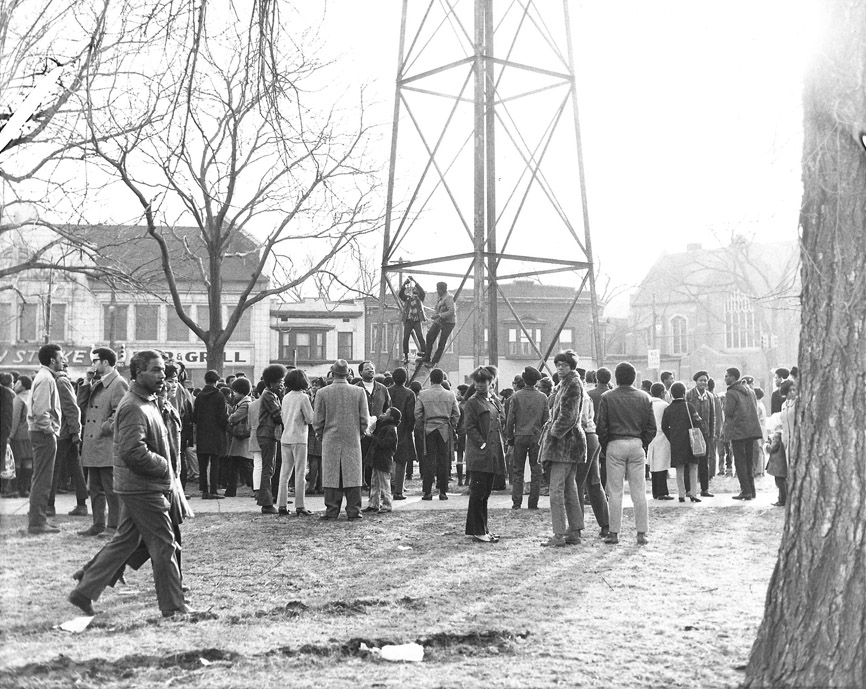
The following article is excerpted from a report on two columns by Jaramogi Abebe Agyeman, then known as the Rev. Albert B. Cleage, Jr., which were originally published in The Michigan Chronicle on May 4 and June 29, 1968, respectively.
Jaramogi Agyeman was the charismatic founder and pastor of the Shrines of the Black Madonna of the Pan African Orthodox Christian Church (PAOCC) and the father of Black Christian Nationalism (BCN), its sacred-secular creed of Black Power, or self-determination, which was proclaimed on Easter Sunday, March 26, 1967.
The Shrine sought to reclaim the African roots of Christianity and, at least until the passing of its founder on Feb. 20, 2000, to restore the historic sovereignty of black people, who were considered the scattered “Black Nation, Israel,” by forming a “black nation within a nation,” which included governing majority-black communities.
During his half-century in the black liberation struggle, he was called the “Apostle of Youth” because of his deep concern for and involvement with the education of young black persons, particularly with regard to addressing their inculcated sense of self-hatred, or “Acceptance of Black Inferiority” (ABI). From the 1960s to the 1990s, he was aided in this concern by the substantial percentage of Shrine members who were teachers.
The report and two of his weekly “Message to the Black Nation” columns dealt with ideas that he presented at “Project Salvation,” a Black Ministers-Teachers Conference sponsored by the Black Teachers Workshop at the University of Detroit-Mercy on April 27, 1968. It was attended by 300 conferees from across the country.
While much has changed in the Detroit Public Schools (DPS) since then, much has remained the same, or gotten worse, including the anti-democratic takeover of DPS by a black Emergency Manager imposed by Michigan’s white, racist, right-wing governor, who’s doing the bidding of corporations.
In light of the deplorable state of our schools and the dangers posed by young “monsters” here and across the country, many of Jaramogi Agyeman’s insights and prescriptions remain relevant. — Paul Lee
How many monsters did you create today?
A message to black ministers and educators
By Jaramogi Abebe Agyeman
(Rev. Albert B. Cleage, Jr.)
[Monsters are persons who prey on others because they have no sense of social or human identity.] Both the schools and churches have created these monsters. They have taught black children to hate black people and therefore to hate themselves.
Now that they have seen what white people are like, they also hate white people and have abandoned the integration dream which sustained the older generation. With nothing to attach themselves to, a whole generation of lonely, vicious youth is now running up and down the streets, grabbing pocketbooks, knocking down old women, taking anything they can lay their hands on, concerned only with their own individual selves.
Unless the black church can give these young people a positive self-image and something to attach themselves to, they will destroy not only themselves but all of us.
* * *
…black churches do not play any important part in the education of black children other than the destructive one of handing down the white supremacy power symbols of a white Jesus and a white God.
The school is a white institution which perpetuates and hands down the white man’s interpretation and conception of the world. We clean up our little children, tell them to study hard and send them off to school where almost everything they learn is a distortion of the truth.
White-dominated schools teach white supremacy. … In school libraries the books are predominantly white supremacy books. In every book about Africa, “the native” has a bone in his nose. They say that they are changing the books but you stop and look. The bone is shorter, that’s all.
The books and the personnel are still teaching the same point of view: white people have done everything in the world that was worth doing and poor primitive black people have been the kindly white man’s burden. This destroys our children.
The problem is with us
[Many teachers and preachers] are overly optimistic about black parents. They seem to think that black parents are fed up and want a basic change. I do not think that black parents are fed up. If they were, they would keep their children out of school until the schools are changed. We can change the schools any day that we decide that black children are important enough.
Perhaps the most pitiful thing is the fact that many black parents still believe that white folks know best how to educate black children. When they see too many black teachers in a school, they are upset. “This school is entirely black,” they say and begin looking for a place to move where they can get their children into an integrated school. It is pathetic.
Basically the problem is with us. We cannot expect white folks to be seriously concerned about educating black children. Why should we expect them to be? We know how they treat us in employment — keeping us in the poorly paid jobs at the bottom.
We know how they treat us when it comes to selling a house — charging $19,000 for a house they would sell a white person for $15,000. Why should they be any more democratic when it comes to education? I am not surprised at them but I am surprised that it takes us so long to wake up and do something to change an educational system that our tax dollars support.
Our children are being destroyed by the schools and we are doing nothing to prevent it. Some of you will say, “Our children are not so bad.” But you know as well as I do that our black children will knock an old black woman down, rape her and take her purse containing 50 cents.
These are not just “bad kids.” These are children in a white civilization who do not have any sense of identification with anything and who do not believe in anything. These are black children who have been destroyed by the black church and the white[-dominated] school.
Do you know what saved some of you older people when you were growing up? You had a dream. Your mother told you that if you studied hard, you could rise above other black folks. She told you that if you washed your face, stood up tall and walked proud, white folks would accept you.
So you spent your time trying not to be like black folks and trying to be like white folks. In a sense that saved you. As asinine and ridiculous as it now sounds, that is what saved a lot of older black people. It was a foolish dream but it was a dream. It was something to hang on to.
We hated ourselves. We did all we could to escape from ourselves. In church on Sunday we tried to shout our way right out of our black skins.
What dream do our children have?
Now let me ask you, What dreams do our children have? They know that the old integration dream is dead. They know that the white man does not want them and they do not want the white man.
Those who belong to the Nation and attend the Shrine of the Black Madonna reject the old integration dream just as black children do. But we have something to put in its place. We are working to build a black community that we can be proud of. We have a new dream to take the place of the old dream that is dead.
But most of our young people don’t have anything. They hate themselves. They hate white people. They hate everybody. They have been psychologically murdered by the black church and the white[-dominated] school.
Look at the black community. What does a black child have to identify with? When he goes to church, he sees white folks in Sunday School lessons, white folks in the stained glass windows, and a white Jesus up front over the altar.
When he rejected the integration dream and white folks, he rejected all of them, and he is not going to come into a black church and make an exception for a white Jesus. So you don’t see our young people in churches. The church doesn’t have anything to offer so young people stay away.
Our children are mad, evil, lonesome. They feel cheated and left out. They strike out at the world in anger and frustration. This is the basic task of the Black Nation.
The only thing that can save a black child is a Black Nation that they can come into. For a black child it is the difference between life and death. For a black child this is the only thing that he can come into that will give him a sense of identity.
Out there on the street, he has nothing to believe in and having nothing to believe in is psychological death for any child.
* * *
We feel that most ghetto schools today destroy children rather than educate them. The teachers and administrators serve as power symbols and kill a black child’s self-image. Their influence, their lack of concern, and in many instances their contempt make it impossible for a black child to learn.
So, we are insisting more and more that in a school for black children … its curriculum be reoriented to cover the culture of black people; that the present textbooks, which are essentially lies, particularly in the area of social science and history, be thrown out and that textbooks explaining the history and cultural background of black people be substituted. We are not insisting that white schools teach the truth, but we do insist that schools in black ghettos teach the truth.
______________________________
This column was edited by Highland Park scholar and Michigan Citizen historical features writer Paul Lee, who indicated omissions with ellipsis (…) and paraphrases and clarifications with [brackets] and separated the Michigan Chronicle report and columns with asterisks (* * *). The subheadings are the Chronicle’s.
I’d like to thank Sala Andaiye (Adams) and Peter Goldman for their helpful proofreading, and Baba Malik Yakini for his sage counsel. — Paul Lee
Editorial Matter Copyright © 2012 by Paul Lee

In 1965 the idea of the Black Star Co-op was born at Central United Church of Christ. In 1968, the year after the Detroit riot, a grocery store was opened a block from the church. Due to a variety of reasons – inexperience of management and staff, costs of keeping enough stock, high prices – the store did not last long. Later the church operated a long running food co-op. Several people would go down to Eastern Market early Saturday morning and buy produce which was shared by everybody who paid $5 that week. There was no overhead and no paid staff. Later the church had a farm in Belleville, Michigan and the food for the co-op came off of that farm. Below is a short photographic story of the Black Star Market.

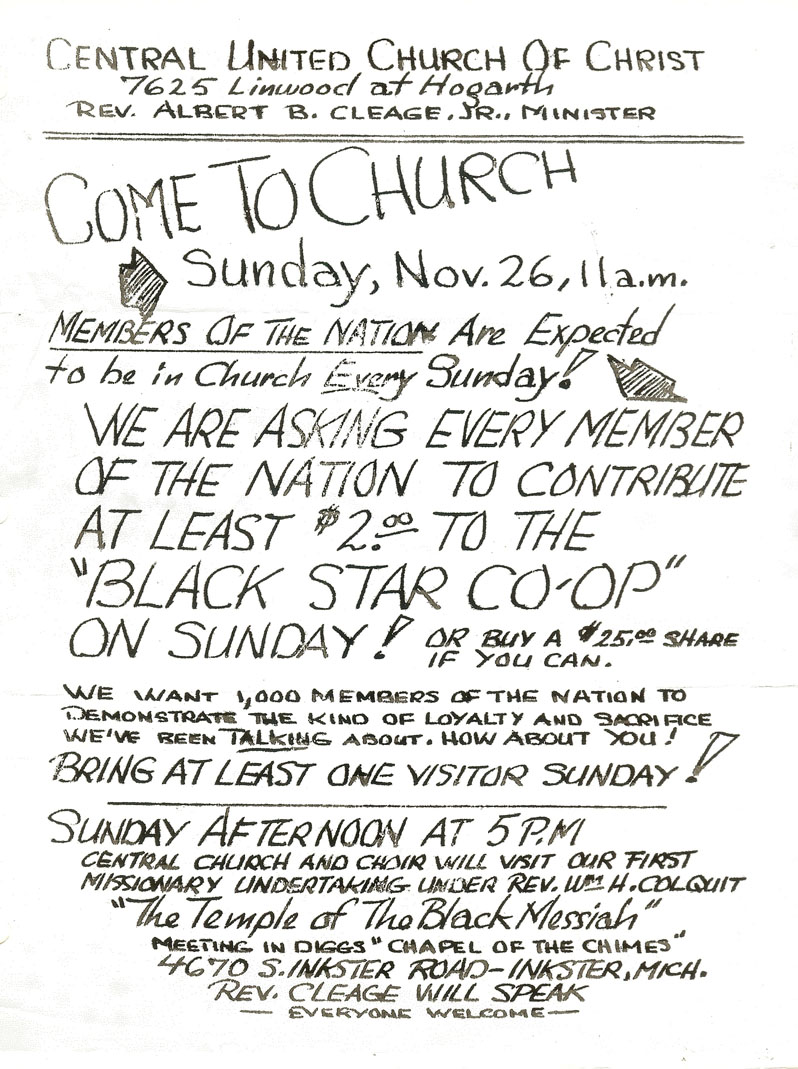
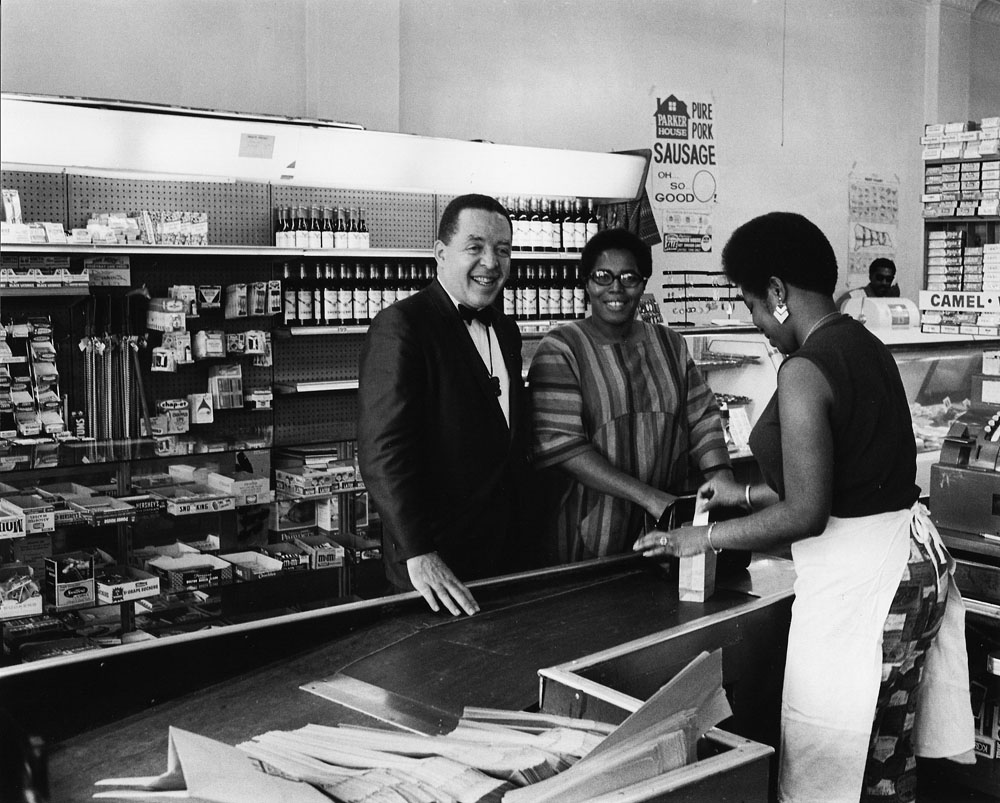
To read more about the church and the street it stand on, click on these links: “L” is for Linwood (About the street of Linwood), “H” is for Linwood and Hogarth (About the church).
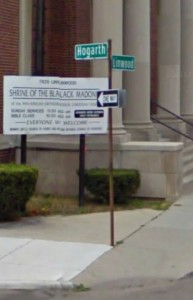 This post continues a series using the Alphabet to go through streets that were significant in my life as part of the Family History Through the Alphabet Challenge.
This post continues a series using the Alphabet to go through streets that were significant in my life as part of the Family History Through the Alphabet Challenge.
The church still stands on the corner of Linwood and Hogarth in Detroit. It has gone through several names through the years, beginning as Central Congregational Church in 1953. It became Central United Church of Christ after the merger of the Evangelical and Reformed Church and the Congregational Churches in 1957. In 1967, after a large mural of the Black Madonna was painted for the Sanctuary, it became the Shrine of the Black Madonna. My father was the minister. I am going to write about my memories from the 1960s as I was growing up.
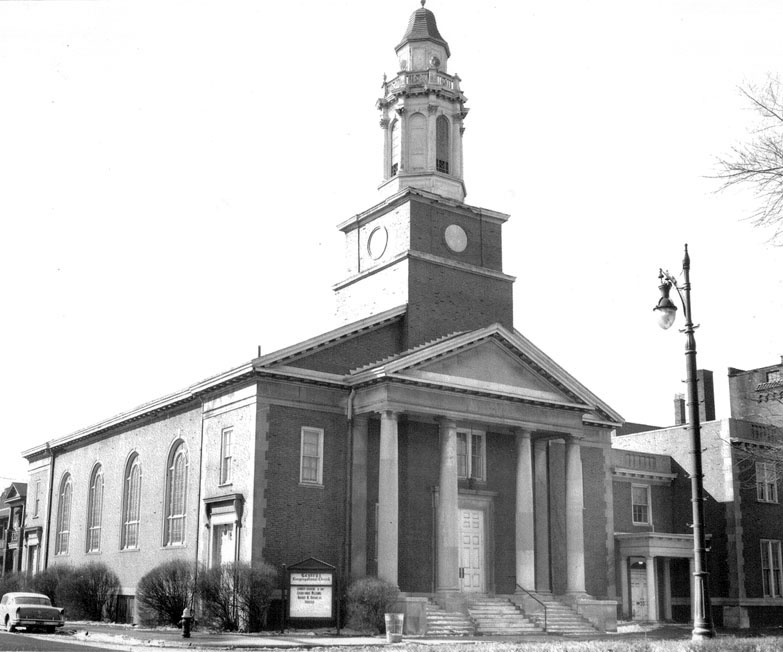
I remember many hours spent at church. There were church suppers and political meetings. There were Christmas Eve services, Christmas caroling and my father’s annual “Little Patricia” Christmas sermon. He gave these for several years. They featured a little girl living in a cave with her family following a nuclear war. I think the last time he gave this sermon she had two heads. I remember a bazaar with booths of handmade items to buy as gifts and game booths with a shooting gallery. The year I remember best was 1962, during the Cuban Missile Crisis of late October. A nuclear war seemed all too possible. I was 16.
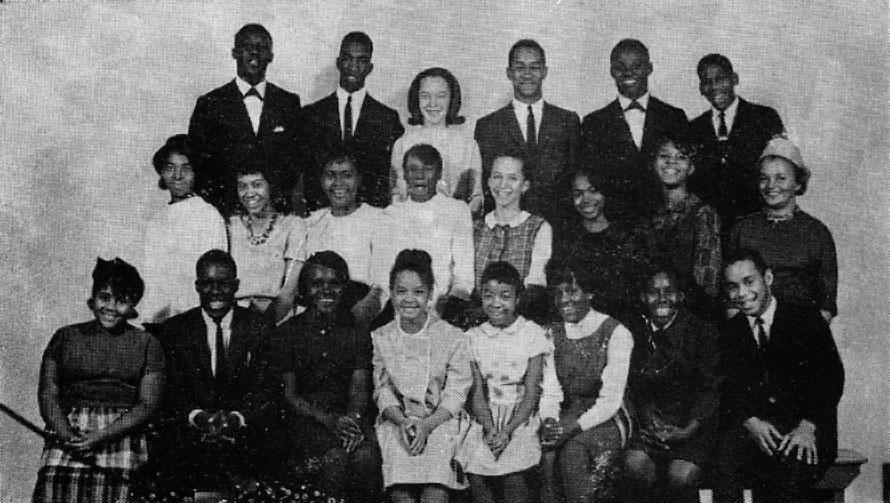
I remember Youth Fellowship meetings, where we talked about what was happening in the city, and around the country. Afterwards there was a social hour. Standing next to the coke machine and not being asked to dance, while at the same time, dreading being asked to dance, is not one of my happier memories. Social hour became less stressful once a ping pong table was added for those of us who didn’t dance much. I remember Workdays for Christ where we spent the day doing yard work to raise money for international service projects. And the “Friendship Circle” where we held hands and sang camp song like “Tell Me Why The Stars Do Shine” and “A Friend on Your Left and a Friend on Your Right”.
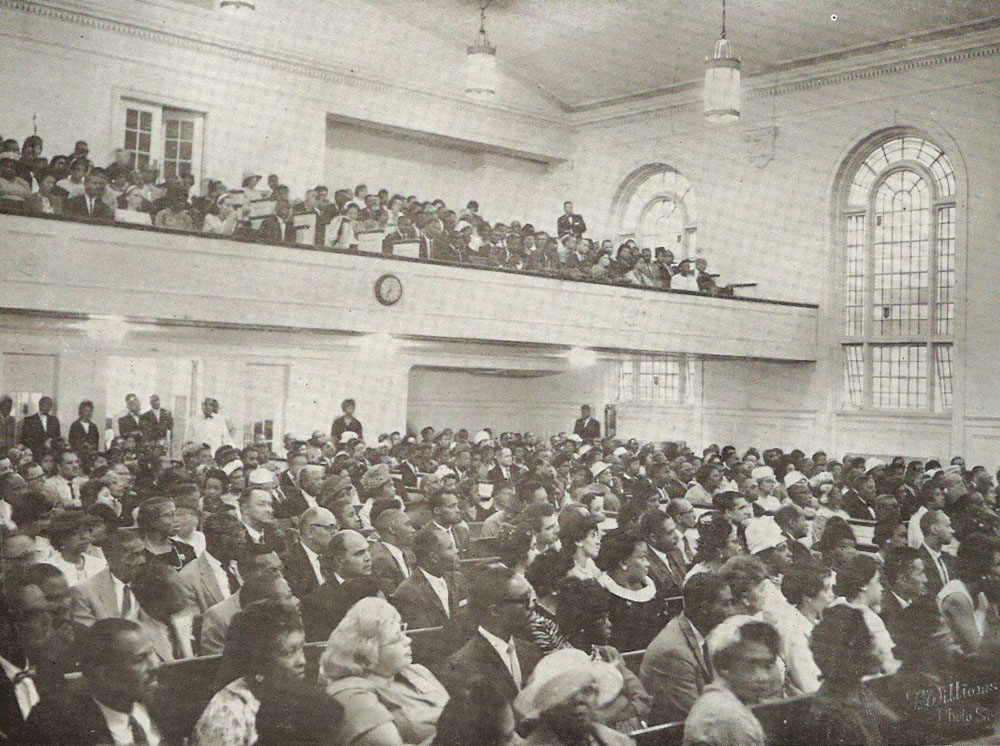
I remember the choir director, Oscar Hand (far right above) singing and the time he held the door open for someone stealing a typewriter because he thought it was the repair man. There was a wonderful production of “South Pacific” one year. There was the tragic and shocking murder/suicide of two married choir members. They had been having a clandestine affair. Mostly though I remember the good singing Sunday after Sunday.
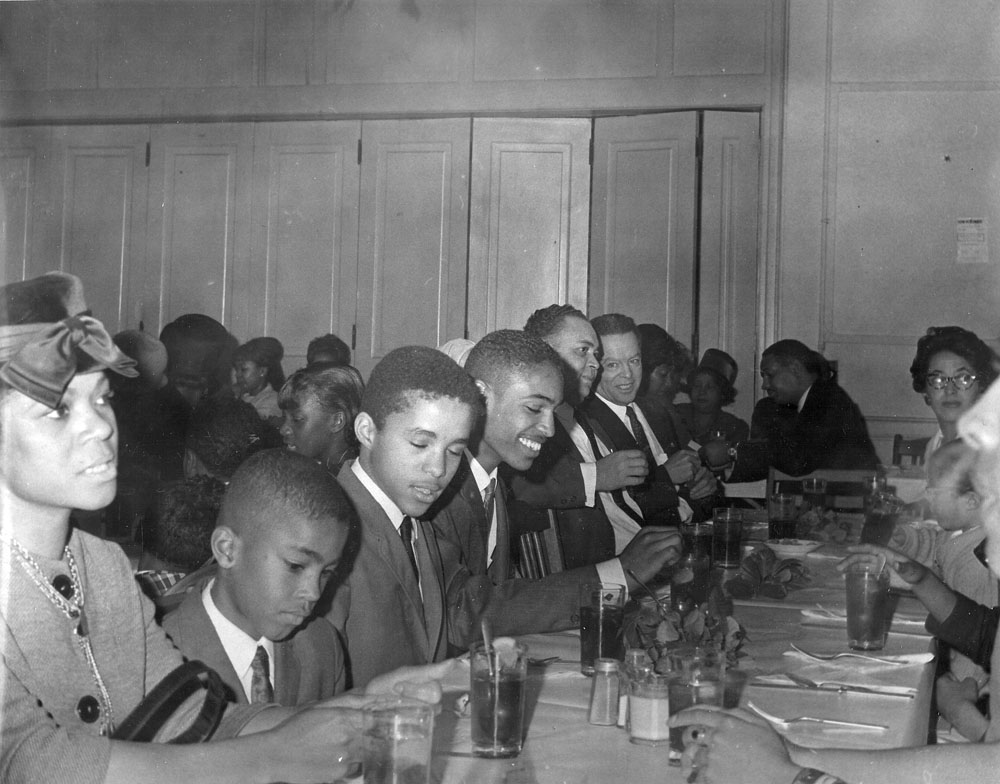
There were lots of church dinners. All members were organized into Area Groups that raised money and sponsored events for socializing. Sometimes Area Groups sold dinners to take out. I remember one such sale. Nobody was coming in to buy the dinners until one of the women suggested burning onion skins. They laughed about it, but someone burned some onion skins and people actually started to come.
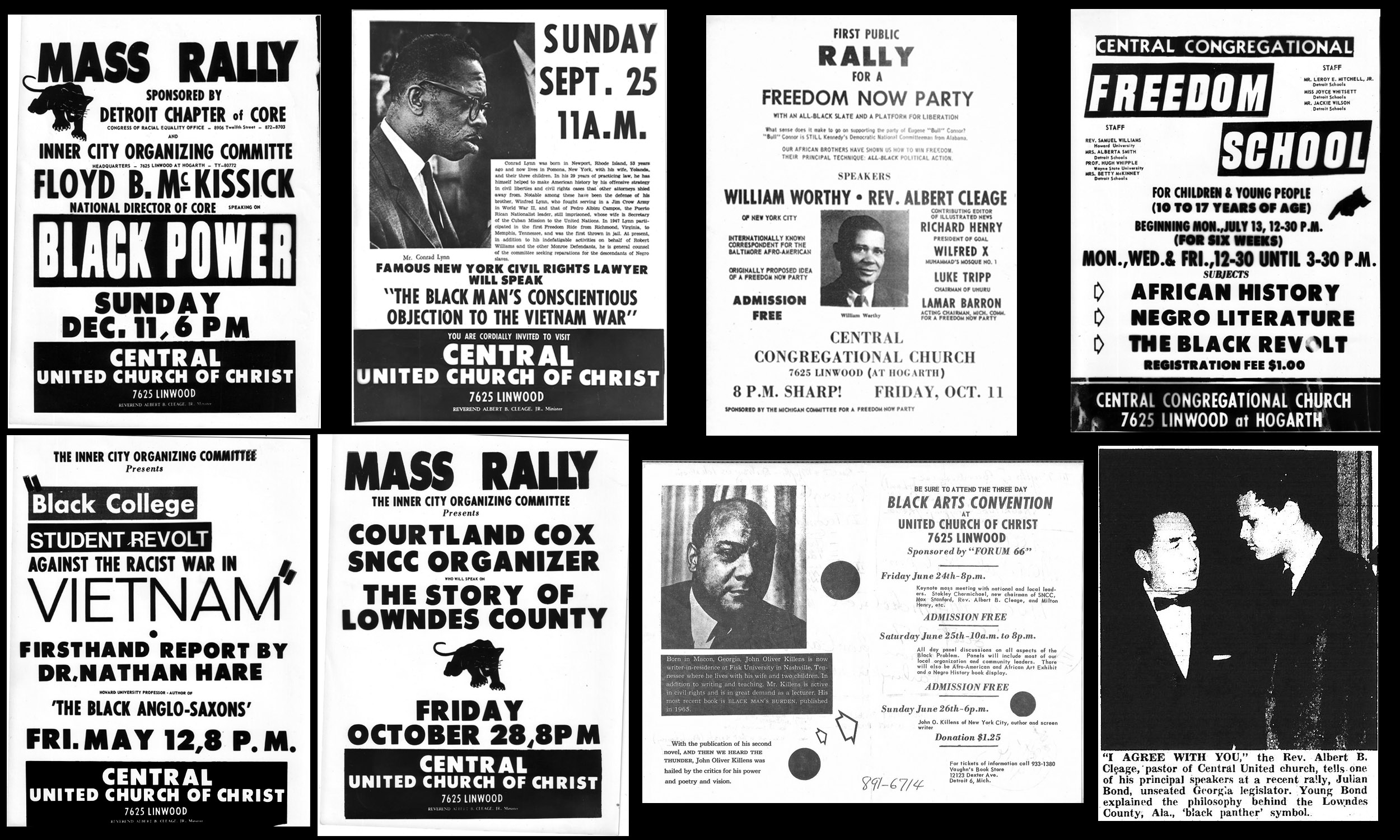 The Church was fully involved in the movement for equal rights and black power. There were always speakers and rallies and seminars.
The Church was fully involved in the movement for equal rights and black power. There were always speakers and rallies and seminars.
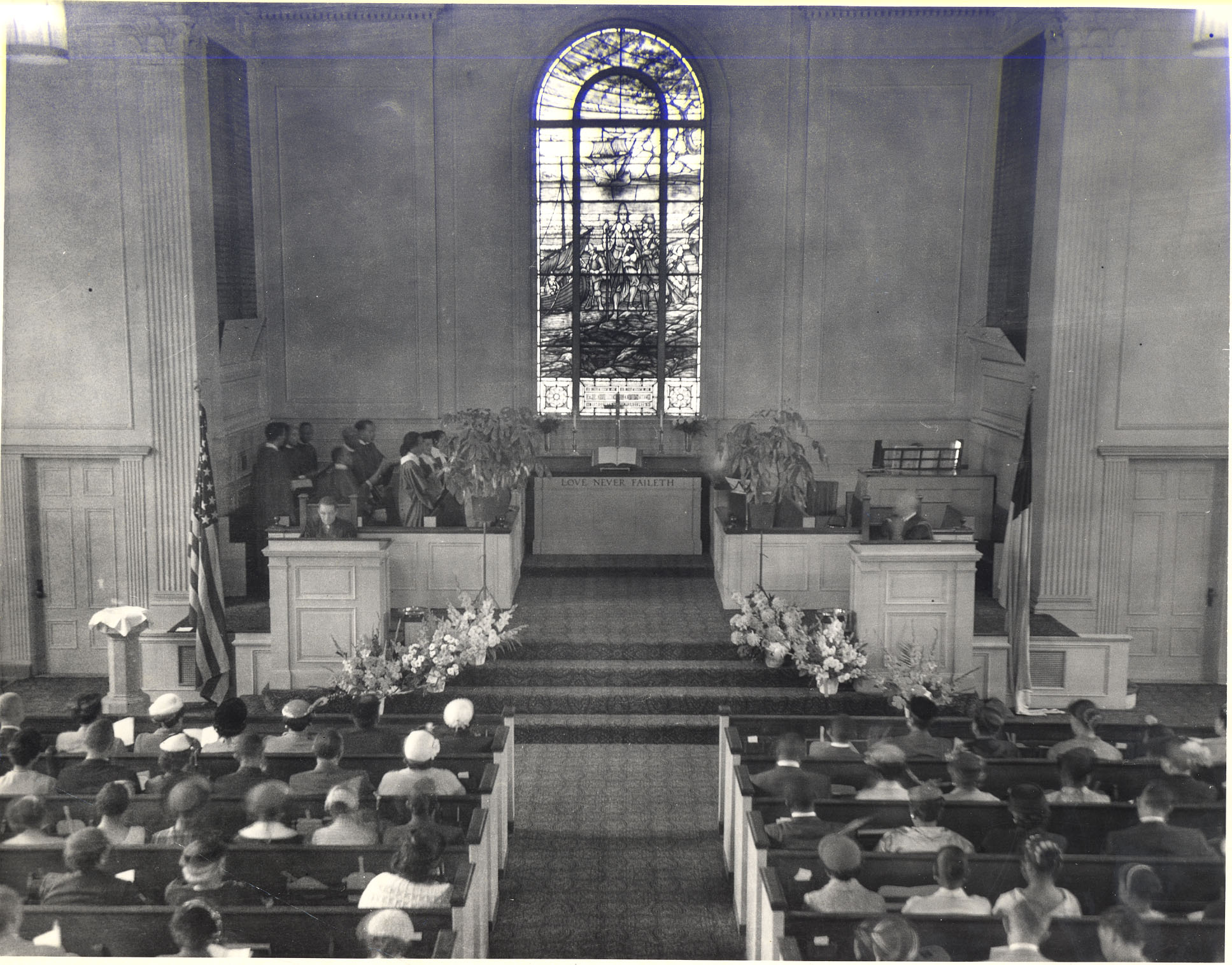
My parents divorced when I was 8. We lived with my mother but often spend the weekends with my father. He would start writing his sermons Saturday night. He wrote at the kitchen table. There were piles of old mail, old sermon notes and who knows what, piled up at one end of the table. There was enough space for the three of us to eat and for him to write. He wrote late into the night, sometimes taking breaks to come in and comment about what we were watching on TV or to order some shrimp from Jags up on 12th street. He never finished the sermon on Saturday. Sunday morning he would get up early and continue writing until the last minute when we would get in the car and drive down Linwood to church. Sometimes there were slow drivers in our way or people had already parked in his usual spot so he had to park farther away. At that time, he always parked on Lamothe, which was what Hogarth was called on the other side of Linwood. Service started at 11. Sunday morning excitement – would we make it!? We always did.
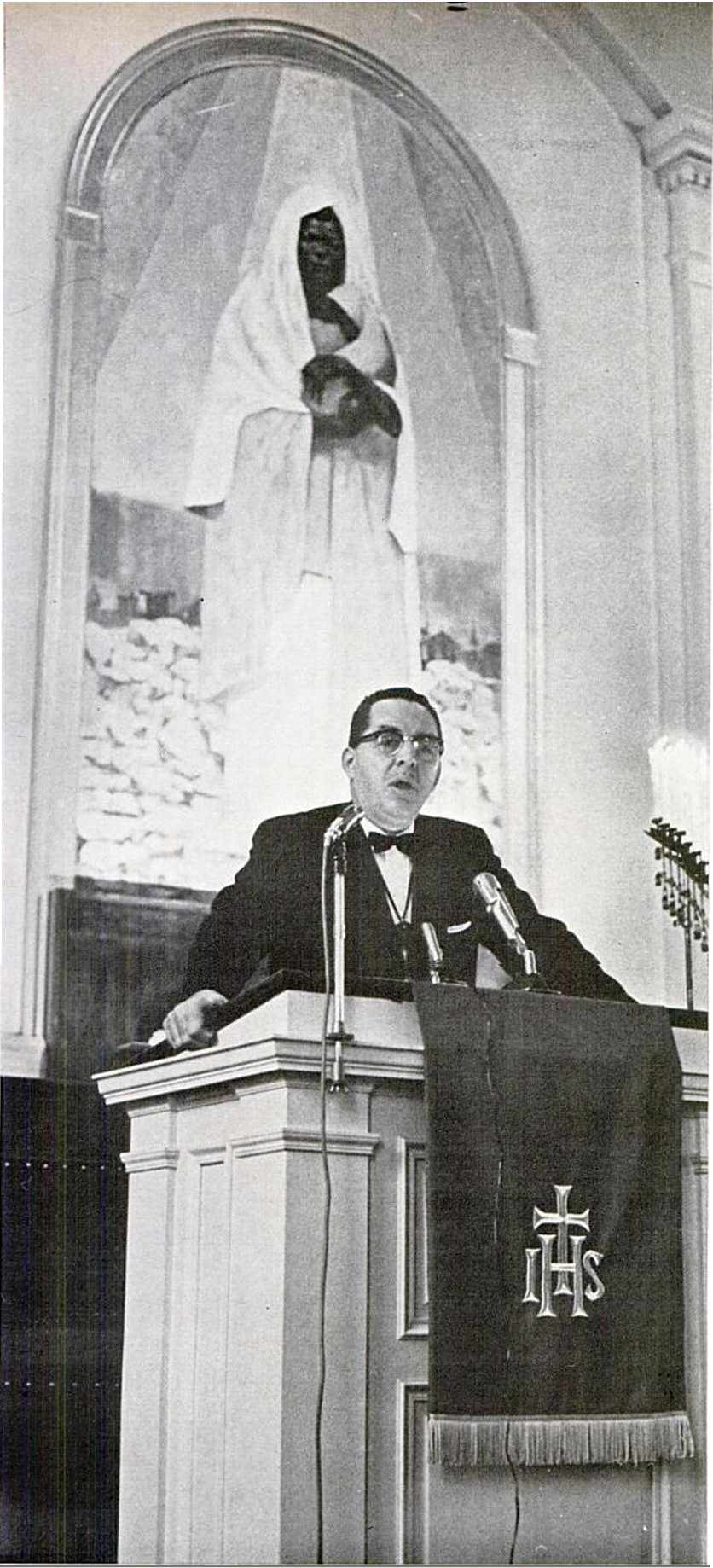
The bulletin and sermon notes below are from Sunday, July 3, 1966.
His sermons always spoke to what people needed to understand about their lives in the present day. And they were always timely. Someone once asked me if he planned and wrote them maybe weeks or months ahead of time. He didn’t. And you could tell because of the current issues he always included.
